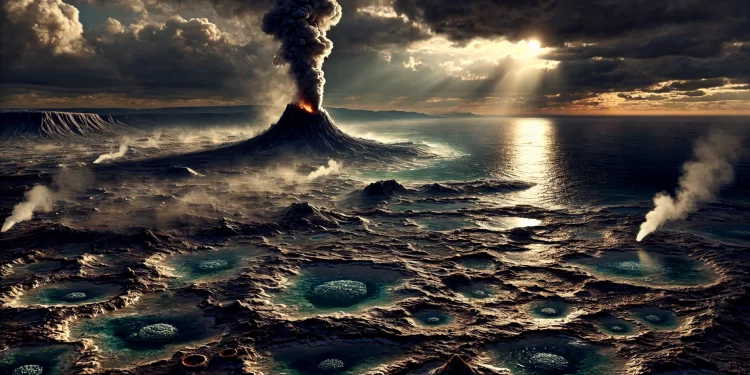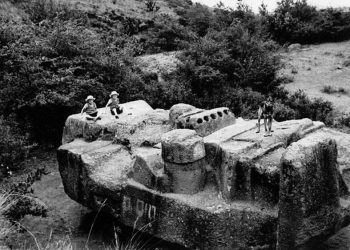For as long as humans have gazed up at the stars or pondered the world around them, one question has lingered: How did life begin? It’s an age-old mystery that continues to capture the curiosity of scientists and non-scientists alike. Was it a sudden event, or did it unfold slowly over millions of years? Today, scientists are looking at the origins of life through the lens of abiogenesis, which is the idea that life sprang from non-living matter somewhere in Earth’s distant past.
Theories about how this could have happened have developed alongside scientific advances. They take us from early Earth’s bubbling oceans to the far reaches of space, with each idea offering a different perspective on how life might have started.
The Primordial Soup: A Rich Stew of Early Life?
The first major scientific idea that really tried to answer the question of life’s beginnings was the primordial soup theory. This theory, born in the early 20th century thanks to scientists like Alexander Oparin and J.B.S. Haldane, suggests that Earth’s early oceans were filled with organic compounds—think of it as a chemical soup. According to this theory, lightning strikes or ultraviolet radiation may have triggered reactions in this “soup,” eventually leading to the formation of life’s basic building blocks.
Fast forward to the 1950s, when an experiment by Stanley Miller and Harold Urey gave us something tangible. By recreating what was believed to be the conditions of early Earth in a laboratory, they were able to produce amino acids, the building blocks of proteins, from simple gases and electricity. It was a thrilling result and seemed to suggest that under the right conditions, life could indeed emerge from non-living matter.
However, as time has passed, doubts have been raised about whether Earth’s early atmosphere actually had the right mix of gases for this theory to work. This doesn’t mean the idea has been thrown out, but it does suggest that the full picture might be more complicated than we first thought.
Life at the Bottom of the Ocean? The Hydrothermal Vent Theory
When we think about life, we tend to picture it on the surface of the Earth—plants, animals, humans. But there’s a whole other world deep beneath the ocean, and that’s where the hydrothermal vent theory comes in. Discovered in the 1970s, hydrothermal vents are cracks on the ocean floor where superheated water rich in minerals escapes from the Earth’s crust. These vents were found to be home to entire ecosystems of life, surviving in complete darkness without any sunlight.
This led scientists to wonder if life could have begun in these deep-sea environments. The minerals and chemicals pouring out of the vents could have provided the perfect setting for organic molecules to form and eventually combine into something more complex. What makes this idea exciting is that it shows life doesn’t necessarily need sunlight—it could thrive in extreme conditions, even in places as far off as the moons of Jupiter or Saturn.
It’s a wild thought, but one that suggests life might be a lot more adaptable than we once believed.
The RNA World: Life’s Early Genetic Code
Another major theory that’s gained traction over the years is the RNA world hypothesis. It turns out that before DNA became the blueprint for life, another molecule called RNA might have played the starring role. RNA is a molecule that, like DNA, can carry genetic information, but it can also act as a catalyst for chemical reactions, much like proteins do.
Scientists think that early life may have been based on RNA rather than DNA. In this scenario, RNA molecules might have been capable of copying themselves, making them the first step toward life as we know it. The discovery of ribozymes—RNA molecules that can catalyze reactions—supports this idea and shows that RNA could have taken on multiple roles in early life forms.
But, as with many of these theories, the RNA world hypothesis also comes with challenges. RNA is fragile and can break down easily, so how it could have survived long enough to evolve into more complex systems is still something researchers are trying to figure out.
Panspermia: Life from Outer Space?
Finally, there’s a theory that’s as intriguing as it is controversial: panspermia. This idea doesn’t try to explain how life began but rather suggests that life, or at least the ingredients for it, came from elsewhere in the universe. The thought is that life might have hitched a ride to Earth on a meteorite or comet. In fact, we’ve found organic molecules in space, and we know that some microorganisms can survive the extreme conditions of space travel.
It’s a fascinating idea because it makes us wonder whether life on Earth is just one part of a much larger cosmic story. Of course, if life came from elsewhere, that still leaves the question of how it started in the first place—but it does open up the possibility that life could exist on other planets or moons in our solar system.
So, What Do We Know?
The truth is, we don’t yet have all the answers. Each of these theories provides valuable insights, but none can fully explain the leap from chemistry to biology. The question of how life began on Earth is still one of the biggest mysteries in science, and there are likely pieces of the puzzle we haven’t even discovered yet.
But one thing is clear: Life, in all its complexity, probably didn’t start in one place or at one moment. It was likely a gradual process, with many different factors at play. As scientists continue to study ancient rocks, explore the ocean’s depths, and peer into the far reaches of space, we’re getting closer to understanding this incredible process.
The search for how life began is ongoing, and each new discovery brings us one step closer to the answer. Whether it started in the rich chemical stew of the primordial oceans, at the bottom of the sea near hydrothermal vents, or came from beyond our planet, one thing is for sure—life is resilient, adaptable, and endlessly fascinating. As we explore more of our own planet and venture into space, the possibilities for uncovering new clues about life’s origins are endless. In solving this mystery, we might not only discover how life began on Earth but also how it could exist elsewhere in the universe.











